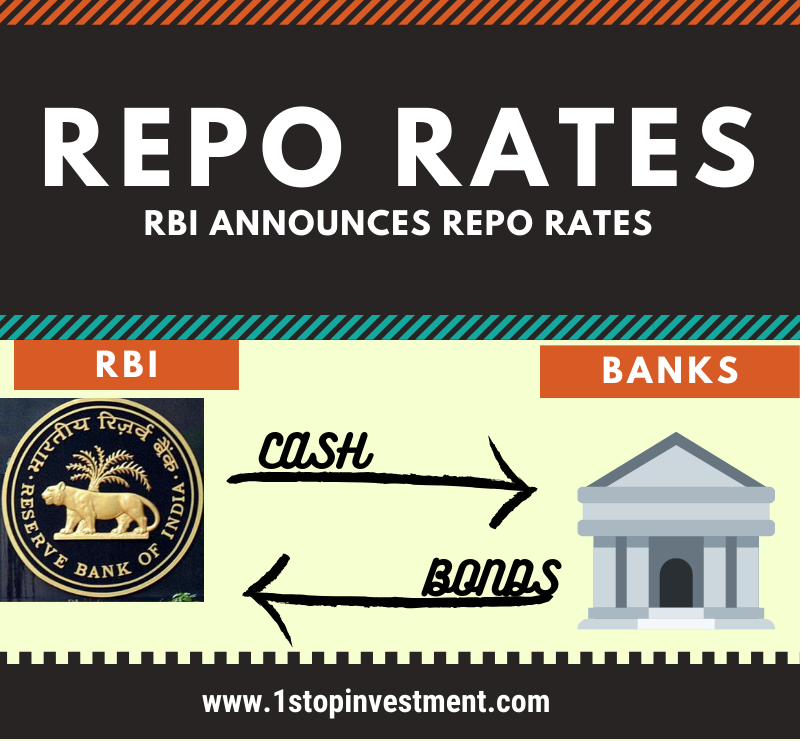Recently, Reserve Bank of India (RBI) on Friday announced No Change in repo rate at 4 percent from 04 June 2021.
Earlier, It announced a 40 bps(Basis points*) cut in repo rate to 4 percent from 4.4 percent earlier on 22 May 2020.
*(100 basis points = 1 percent).
Are you looking for any below ?
What is Repo Rate?
Repo (Repurchase Options) rate is the rate at which the Central bank of a country lends money to commercial banks. In India, Reserve Bank of India lends money at an Interest rate to the banks by accepting their securities.
In Simple terms, Banks sell approved government securities to RBI and get funds in exchange at an Interest rate. This interest rate is called the Repo Rate.
RBI repurchases govt. securities from the bank depending on the prevailing Economy situation of India.
Overnight lending is followed in the transaction between banks and RBI which means Banks give government bonds of the borrowed value to RBI as a collateral to get funds and buys back bonds after a day with the Principal & Interest amount.

Why Banks borrow from RBI?
Let me tell you in a simple way, Banks give interest to depositors and lends the same money to others who lend from the bank and collects interest from them.
Imagine, when there are fewer deposits of money and more people want a loan, there will be a shortage of cash funds in their books. So Commercial Banks approach RBI for funds and Liquidity issue gets resolved in this way.
- Depositor continues to receive interest
- People receive loans who are in need.
- RBI gains interest from Banks.
- Banks Continue to operate.
How it helps the economy?
RBI uses the REPO rate as an instrument to control Inflation in the country.
If there is an inflation in the economy, RBI increases the repo rate and it would be a burden for the banks to get funds at higher interest rates. So RBI controls inflation by reducing the money flow in the market.
If RBI decides to reverse, they decrease the repo rate to increase the money flow in the country.
Simply, the Repo rate is a Liquidity controlling tool for RBI.
The current repo rate in India is 4.00%, effective from 04 June 21.
India’s Repo Rate Histroy Trend Chart:
Source : RBI
The Repo rate changes have an impact on a wide range of people from the banking sector to the Individual people.
How Repo rate changes Impact on economy:
Whenever there is a change in repo rate, The lending rates and deposit rates will also get impacted.
Always When RBI announces a meeting, there will be expectations from the market. There are three possible outcomes from RBI.
- Increase in Repo Rates
- Decrease in Repo rates
- No Change in Repo Rates
Increase in Repo Rates
- If the repo rates are hiked/increased by any basis points, the banking sector is the frontier going to take the major hit as it affects directly their interest rate burden.
- Then Banks will pass on their burden to the common people and Increase their Lending rates.
- So Common people have higher EMI costs for their loans.
- If the interest rates are higher, then this will slow down their business on the Housing loan sector and other floating interest rate loans.
- This will reduce Consumer purchasing power and reduces the cash flow in the economy and stabilizes the Inflation.
- Also, Banks provide a higher interest rate for the fixed deposits to invite more cash flow from its customers. This will happen with Bank’s Liquidity position. If they are a shortage of funds, they will announce sooner.
Decrease in Repo Rates
- Banks breathe easy as and when there is a cut in repo rates. Because, Banks get loans from RBI at low-priced rates.
- This will boost banks to lend money at cheaper rates than earlier rates to gain more consumers. As the EMI cost is low, People tend to avail it and increases the cash flow in the economy.
- But, it affects the Fixed deposit holders. Banks will reduce the fixed deposit rates across their FD schemes.
No Change in Repo Rates
- Mostly there will be no impact and everything will be at the same cost as usual.
Conclusion
It is always better to know the repo rates and it helps in understanding the interest rates and lending rates linked to it.
Continue Reading on Reverse Repo Rates.
Happy Investing.






